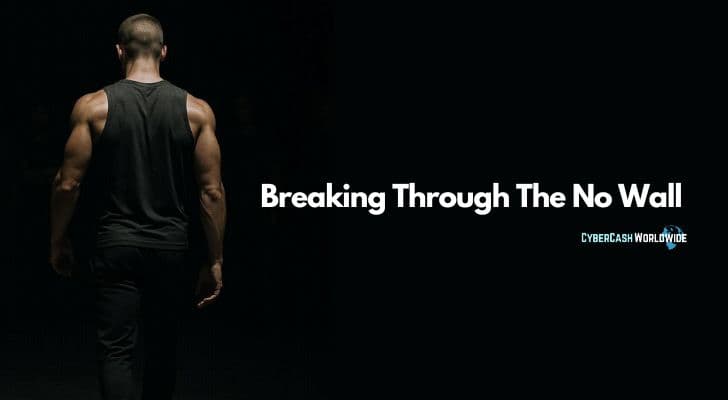Most people treat rejection like kryptonite - one touch and they're down for the count. The truth hits different when you realize that every successful person has a graveyard of rejections behind them, each one serving as a stepping stone to their eventual breakthrough.
Every "no" you collect becomes intelligence about what doesn't work, pushing you closer to the strategy that finally works. The distance between where you stand now and where you want to be gets measured not in miles, but in the number of rejections you're willing to accumulate along the way.
Smart people flip the script entirely - they start hunting for rejections instead of hiding from them. The conventional wisdom tells you to avoid situations where you might get turned down, but winners deliberately seek out scenarios where rejection becomes highly likely. This counterintuitive strategy builds your tolerance for disappointment while simultaneously increasing your odds of eventually hitting the jackpot. When rejection transforms from your greatest fear into your daily practice, everything changes.

The Psychology of Hearing No
Your brain processes rejection the same way it handles physical pain, flooding your system with stress hormones and triggering your fight-or-flight response. Most people never train themselves to handle this psychological assault, so they remain vulnerable to emotional crashes every time someone turns them down.
The secret lies in rewiring your neural pathways through repeated exposure, teaching your mind that rejection equals information rather than devastation. After enough repetitions, your brain stops treating "no" like a catastrophe and starts treating it like weather - temporary and largely irrelevant to your long-term success.
Building Rejection Tolerance
Start with small, low-stakes rejections that won't derail your life if they go sideways. Ask for discounts at stores that never give discounts, request upgrades on flights when you're clearly in economy, or try to skip lines when you know the answer will be negative.
These micro-rejections act like vaccines, introducing your system to small doses of disappointment so you build immunity against larger setbacks. After a month of daily rejection practice, you'll notice that bigger rejections lose their sting because your emotional immune system has grown stronger.
Reframing The Mental Game
Transform every rejection into a data collection exercise by asking yourself what you learned from each interaction. Maybe your timing was off, your presentation needed work, or you were talking to the wrong person entirely. Each "no" becomes a piece of the puzzle showing you exactly what adjustments to make next time.
The people who quit after their first few rejections never get access to this valuable feedback loop that separates amateur efforts from professional results.
The Numbers Game Nobody Talks About
Success operates on mathematical principles that most people ignore because they're too busy taking rejection personally. Every industry, every field, every type of human interaction has predictable conversion rates - and those rates usually involve far more nos than yeses.
Real estate agents know they need to make dozens of calls to close one deal, but somehow regular people expect to succeed on their first or second attempt.
When you accept that rejection represents the majority of your interactions, you stop viewing individual nos as failures and start seeing them as necessary steps in a predictable process.
Playing The Averages
Track your rejection rate like a scientist tracking experimental results, because patterns reveal opportunities that emotions obscure. Keep a simple spreadsheet noting your requests, responses, and outcomes - you'll start noticing trends that help you optimize your strategy.
Maybe Tuesdays produce better results than Mondays, or phone calls work better than emails for your particular situation. The data removes the emotional component and transforms rejection into a game with clear rules and measurable progress.

Volume Beats Perfection
Focus on quantity over quality during your initial rejection phase, because you need sufficient data before you start optimizing your technique. Make ten imperfect attempts rather than spending weeks crafting one "perfect" approach that might still get rejected anyway.
Speed teaches you faster than perfection because you learn what works through trial and error, not through theoretical planning.
The people who spend months preparing for one big ask usually perform worse than those who make dozens of smaller attempts and learn from each interaction.
Strategic Rejection Hunting
The smartest players don't wait for rejection to find them - they actively seek it out in controlled environments where they hold the advantage. This proactive strategy lets you choose your battles instead of being caught off guard when rejection strikes at the worst possible moment.
By deliberately putting yourself in rejection-heavy situations when you're mentally prepared and emotionally stable, you build skills that transfer to high-pressure scenarios later. The confidence you develop through voluntary rejection translates directly into real-world situations where the stakes actually matter.
Controlled Exposure Training
Set daily rejection quotas that force you out of your comfort zone without overwhelming your system. Aim for three rejections per day - not three attempts, but three actual nos.
This quota system ensures you're pushing boundaries consistently while building up your tolerance gradually. Some days you'll hit your quota in twenty minutes, other days it might take hours, but the consistency builds habits that serve you long-term.
Rejection as Market Research
Use your rejection conversations as informal focus groups to test different messaging and positioning strategies.Ask follow-up questions when people turn you down: what would need to change for them to say yes, what concerns prevented them from moving forward, or who they think might be interested instead.
These conversations often provide more value than successful interactions because they reveal exactly what's blocking your progress. The feedback you gather from rejections becomes the foundation for refining your strategy until it becomes irresistible.
The Compound Effect of Persistence
Most people quit right before their breakthrough moment because they don't realize how compounding works in the rejection game. Your efforts build momentum invisibly until you suddenly hit a tipping point where everything changes at once.
The rejections you collected last month set up this month's successes, but the connection isn't always obvious in real-time. Persistence creates a compound effect where each rejection increases your odds of success in ways that aren't immediately apparent.
Building Invisible Momentum
Maintain consistent daily action regardless of yesterday's results, because momentum builds through repetition rather than through individual victories. The person who makes five calls every day for six months will outperform the person who makes fifty calls once per month, even though the monthly caller works harder in bursts.
Consistency creates habits, habits create identity, and identity drives results. When taking action becomes automatic, rejection loses its power to derail your progress because you're already moving toward the next opportunity.
The Breakthrough Principle
Expect your biggest breakthrough to happen right after your worst rejection streak, because that's how the compound effect typically manifests itself. The darkest hour really does come before dawn, and most people quit during that dark hour instead of pushing through to see what happens next.
Your worst rejections often mean you're getting closer to people who have the authority to say yes, which naturally means the stakes get higher and the initial resistance gets stronger.
The people who persist through these intense rejection phases often discover that their breakthrough was waiting just one more attempt away.
Rejection as Competitive Advantage

Smart operators view rejection as their secret weapon because most people avoid it so completely. While your competition runs away from potential nos, you collect them like trophies, building skills and resilience that create massive advantages when opportunities arise.
The person who's comfortable with rejection will take risks that terrify others, ask for things that others won't request, and persist through setbacks that make competitors quit. This comfort with rejection becomes a moat around your success that's almost impossible for others to cross.
Market Differentiation
Position yourself in spaces where others fear to tread, because high-rejection environments often contain the highest rewards. The deals nobody else wants to pursue, the clients everybody considers "difficult," the opportunities that require multiple attempts - these become your specialty because you've trained yourself to handle what others avoid.
Your willingness to face rejection repeatedly gives you access to markets and opportunities that remain untouched by your competition.
The Fearless Factor
Develop a reputation as someone who asks for things others won't request, because this boldness attracts people who respect confidence and persistence. Decision-makers notice when someone doesn't crumble after being told no, and they often remember that person when better opportunities arise later.
Your ability to handle rejection gracefully becomes part of your personal brand, setting you apart in a world full of people who give up after the first setback. The relationships you build through persistent, respectful follow-up often prove more valuable than the specific opportunities you were originally pursuing.
Recovery and Resilience Systems
The difference between temporary setbacks and permanent defeats often comes down to how quickly you bounce back from rejection.
Winners develop systematic methods for processing disappointment and getting back into action, while losers let single rejections spiral into extended periods of inactivity.
Your recovery speed determines your overall progress rate because time spent wallowing is time not spent pursuing the next opportunity. The faster you process rejection and move forward, the more attempts you make, and the more attempts you make, the higher your success rate becomes.
The 24-Hour Rule
Give yourself exactly one day to feel disappointed about a significant rejection, then force yourself back into action regardless of how you feel emotionally. This time limit prevents you from getting stuck in analysis paralysis while still acknowledging that rejection stings and needs to be processed.
Set a timer if necessary - when those 24 hours expire, you make your next attempt whether you feel ready or not. The discipline of moving forward despite emotional resistance builds mental toughness that serves you in all areas of life.
Rejection Autopsy Process
Conduct a brief post-mortem after each significant rejection to extract lessons without dwelling on disappointment. Ask three specific questions: what went well, what could be improved, and what you'll do differently next time.
Keep these reviews short and focused on actionable insights rather than emotional processing. The goal is learning, not lingering, so you gather intelligence quickly and move on to your next attempt with upgraded tactics.
Breaking Through The No Wall
The graveyard of dreams is filled with people who let the first few rejections convince them they weren't meant for success. Every winner you admire has a collection of nos that would discourage most people, but they kept moving anyway because they understood something that others missed. Rejection isn't the opposite of success - rejection is the raw material from which success gets built, one disappointing interaction at a time. The question isn't whether you'll face rejection on your path to achievement; the question is whether you'll let rejection teach you or defeat you. Choose wisely, because your future self is counting on the decision you make right now.
How I "Finally" Make Over $7,000 Monthly Income
"The most valuable thing I've ever done!"
